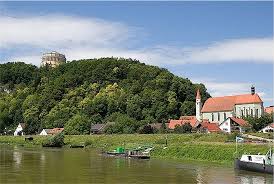 |
Wiltenburg Monastery.
My “Tor” Friend David Jackson got this shot in a most unusal way:
It’s a postcard that he took a picture of! Way to go David and thanks! |
As if the town of Regensburg itself wasn’t enough, the afternoon schedule for “Tor” Passengers gave us more options. Three in fact.
For Motorheads, there was a BMW Factory visit. The plant in Regensburg opened in 1986 and since that time, more than five million vehicles have been produced there and sent all around the world. This guided tour took Tor passengers through the production halls. Cameras were completely verboten. From what I gleaned, this tour was cloaked in secrecy the NSA would be proud of. So I’m afraid I know no more about it. The second option was to stay aboard ship while it moved upriver to the town of Kelheim, a distance of just 27 kilometers but one which took several hours to complete.
 |
| Liberation Hall as seen from the river |
The third option, and the one I took, was to drive to Kelheim, which took all of 30 minutes and begin a tour that ultimately took us to Wiltenberg Monastery.
But first, we travelled through a Bavarian wood to Liberation Hall (Befreiungshalle in German) This massive structure was built by King Ludwig I to commemorate Germany’s struggle against the oppression of Napoleon and the unification of Tuetonic tribes. It took over 20 years to build and its architect died in the process. It’s in the midst of a restoration, covering the 18-cornered building.
 |
The 10 Canadians seen here at Wiltenburg.
Nobody enlivened this trip quite like
these wonderful people from Nanaimo BC |
Confession time: We’re all supplied with ingenious headsets with which we can hear our guides even at some distance. The minute we got to the Hall, I repaired to the men’s room. When I emerged, I walked the wrong way for a quick tour of the parking lot. Realizing my mistake, I walked to the Visitor’s Center. There I spied some of my Canadian friends enjoying a beer. The temperature at this point was 28 C or 82 F. I opted for the beer before heading back to the bus. I never actually visited Liberation Hall.
We then went down to Kelheim where we boarded an excursion boat. With yet another beer in hand, we headed down the Danube Cutthrough, a particularly scenic stretch called the Weltenburg Gap. Rounding a bend, we came upon an enormous structure, pictured at the top of this post. This is Weltenburg Monastery.
In this remote setting, the foundations of its first monastery date from 600 AD. It became a Benedictine abbey in 760 AD. Through endless wars and ecclesiastical disputes, the monastery was destroyed time and time again only to be rebuilt time and time again. The current structure dates from 1714.
The centerpiece of the Monastery is the St. George abbatical church. Of all the magnificent Baroque churches we’ve seen along the Romantic Danube, this one is perhaps the most astonishing. The simple façade makes the extraordinary interior all the more impressive. It is smaller than any one of the others we’ve seen, which makes it ornamentation all the more startling.
 |
This ceiling was painted by Cosmos Damian Asam
who was lifted up on a platform from the floor of the
church to a dizzying height where he painted the ceiling while
lying on his back. |
 |
| Sculpture, Painting, Architecture all in one |
Two brothers, Cosmos Damian and Egid Quirin Asam, painters, sculptors and master builders worked on St. George’s from 1716 to 1739. They succeeded in bringing together painting, sculpture, light, space and architecture into a unified total work of art. Once again, an expert guide took us through every aspect of the Church’s design and decoration. Below, in homage to themselves, Cosmos Damian painted his own image on the ceiling, his brother Egid Quirin, the sculptor, fashioned his own on its lip.
 |
Have another beer! Nicole, Moi, Stanislav,
the Viking River Tor’s Concierge,
Toni, Stephanie and Margaret in another photo
by David Jackson. Thanks David! |
Besides being a masterpiece of High Baroque in Southern Germany, the Monastery has another claim to fame. The monks have been making beer there since at least 1050 AD. In fact their latest offering is a brew called 1050. So much for Colt 45. As odd as it seems, there is a biergarten is right outside the church. It’s thronged with people enjoying the award winning Dunkel (Dark Lager) beer and cheese also made right there. I couldn’t help but think that we Episcopalians could take a leaf from this book. We could set up Martini bars at the back of our churches to encourage that kind of participation!
 |
Last Beer of the Day! Go ahead,
it’s all included! |
We took the excursion boat back to Kelheim. There, we visited yet another biergarten, this one formerly belonging to the local Duke. Miffed by the Monk’s prosperity from beer sales, he founded his own brewery.
At last, we returned to the ship for our German Dinner Celebration and sadly, tomorrow’s final day aboard “Tor”.






